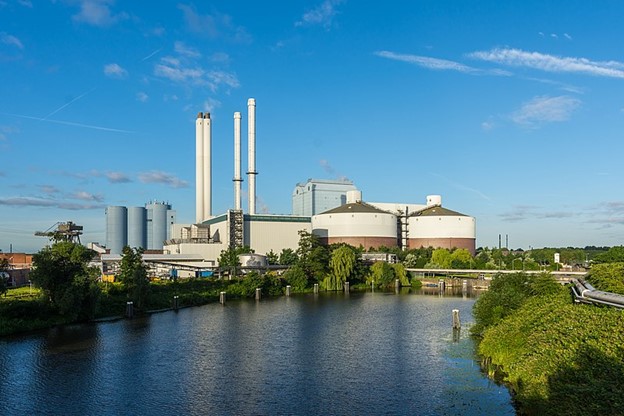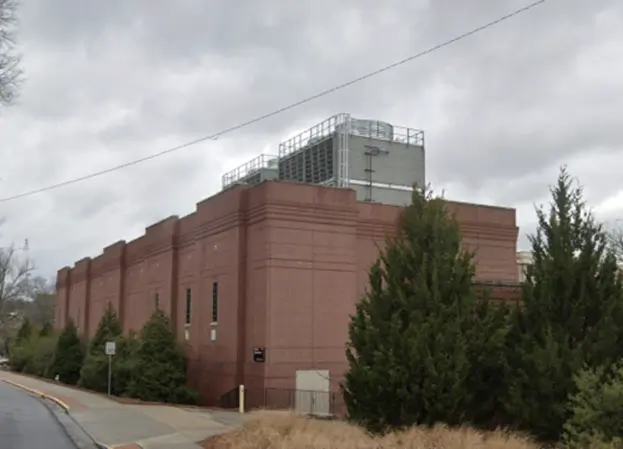
District energy commonly refers to generating and distributing steam, electricity, and/or chilled water from a centrally located plant. While not all District Energy plants supply the same services, they perform the same essential function. This function is to provide the efficient generation and distribution of energy to the area they serve. They are commonly present at Universities, Hospitals, Airports, and Military Bases. Additionally, they are present in areas of dense building settings, like New York City. District Energy systems provide redundant, reliable, and more economical services. This is done by combining the heating, cooling, and sometimes electrical load requirements of multiple buildings.
In most district energy systems, fossil fuel-fired boilers generate steam. The steam then goes to multiple buildings via a piping system to supply heat. This central generation and distribution of steam are more efficient than providing each building with a small furnace or using individual electric heaters throughout large buildings. While many of the older boilers used coal, most have switched to oil and natural gas. In most district heating systems, the condensate that results from the steam condensing in the heat exchangers used in building heating (like radiators) is returned to the heating plant.
The first central electric power plant in the United States, Pearl Street Station, built by Thomas Edison in 1884 in New York (Manhattan), used reciprocating steam engines where the exhaust steam was used for heating buildings near the plant. This design has expanded in use many times over. District energy systems are based on a centralized plant that supplies steam for heating (and sometimes chilled water for cooling) to a collection of buildings, raising efficiency.
The efficiency of a fossil fueled boiler is typically 85% to 90%. About 10% to 15% of the heat available in the fuel is lost (mostly up the stack). The overall efficiency of a District Heating system is considerably less because of the heat losses in the steam and condensate, which are typically about 10%. This brings the overall efficiency of district heating systems to between 75% and 80%. The District Energy plant loses 20% to 25% of the energy in the fuel used. While this may not sound efficient, remember this is the total loss in the system. Therefore, if this system was reproduced on a small scale in each building, there would be a 25% loss PER SYSTEM.

Many District plants generate only steam; or generate electricity that provides use during the process. (like at a steel mill). However, the plants can provide a number of services by sharing the processes the plant itself needs in order to operate, such as:
For example, the Campus Energy Systems at the University of Georgia generate Electricity, Steam, and Chilled Water to supply the University Campus.

District Energy plants can use more efficient technologies (such as Combined Cycle plants) to reduce the cost and environmental impact of the demand for service. Another benefit of District Energy plants is redundancy. Most large power generation facilities power a single generator unit from a single source of steam. Most District Energy Plants, however, contain some combination of coal boilers, natural gas/fuel oil boilers, combustion turbines, and heat recovery steam generators, and steam turbine generators. The design of District Energy Plants provides redundancy to the associated University, municipality, or other customer(s) they serve.
As the world shifts towards the use of renewable energy sources such as Solar and Wind, reliability and capacity have been a major concern. In my previous blog, we discussed reliability and capacity in more detail. California, Texas, and Germany have all made headlines in recent years as they struggled through power outages blamed in part on the inability of their renewable energy sources to meet the demand.
The National Renewable Energy Laboratory, Center for Climate and Energy Solutions and U.S. Department of Energy have entered micro-grids into the discussion as a solution to balance the benefits of renewable energy sources and fossil fuels to meet emissions and demand. Many District Energy plants at universities have jumped on board with this concept. They show how to use it on a much larger scale.
District Energy plants have many uses. Later, we’ll look deeper into the concept of the micro-grid. And dive into how Edison’s Pearl Street Station may be the future of Energy.
For more information about Power Generation, and the different technologies out there, check out our blog page!
Contact FCS for district energy consulting services today!